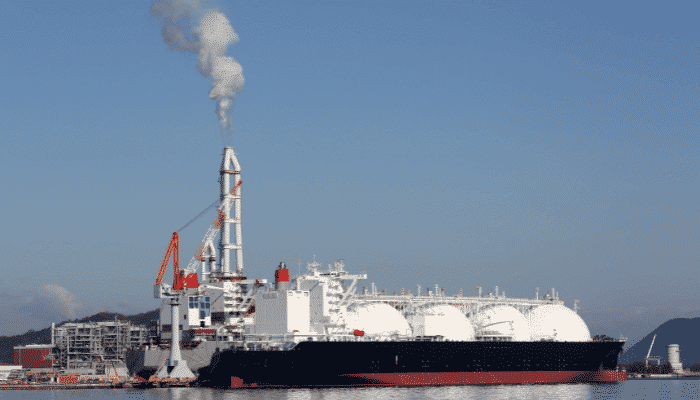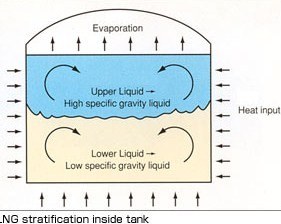What is Rollover Condition in Gas Carrier Ships?
In a gas carrier ship, gaseous cargo having different properties is carried in the same tank if approved by the administration. This is mainly done to help operators and owners to save transportation cost and make some more profit from the same vessel by delivering different cargoes.
When it comes to gaseous cargo, the ship owners have to be extra cautious because of the various hazards associated with it. “Rollover” is one such dangerous situation that can be generated while carrying gas cargo in large tanks.

What is Rollover?
Rollover is the process of spontaneous mixing up of a similar or two different gaseous cargos due to changes in the density of upper and lower layers level in the tank.
This happens because of the boiling off of lighter fractions from the gaseous cargo, resulting in the liquid layer adjacent to the liquid surface to become denser than the layer beneath it. When this situation occurs, stratification develops and the unstable condition relieves itself with spontaneous mixing known as rollover.
Let’s understand this phenomenon with a simple example of two different cargos having dissimilar densities loaded without mixing in a LNG tank. A layering will take place and instability between the layers will occur due to the genuine difference in the density or high concentration of nitrogen in the feed gas.
The lower layer can become less dense as compared to the upper level when the boil off is removed. This leads to evaporation causing increase in the density and decrease in the temperature near surface making lower layer less dense. This unstable situation results in rollover and sudden mixing of gases.
Reasons for Rollover
The various reasons for rollover are:
- When there is temperature difference within the liquid.
- If the cargo is stored for a long time without circulation.
- Similar or Compatible cargo stored in one tank
- If condensate of two or more tank is returned to one tank
Effect of Rollover
- Increase in the boil off rate up to 10 times than the normal condition
- Increase or over pressurisation of the tank
- Lifting of relief valve of the tank
Measures to prevent rollover
- Different density cargo to be stored separately
- Load tank with equipments such as nozzle ( used for shore tanks ) to promote mixing.
- Prolong stoppage to be avoided when loading ship’s tank
- Boil off rate to be continuously monitored
Both the tanks on the shore and ships are subjected to rollover, but the possibility of Rollover to take place is higher in ship tanks due to the size and capability of handling different cargoes in the same tank.
Disclaimer :
The information contained in this website is for general information purposes only. While we endeavour to keep the information up to date and correct, we make no representations or warranties of any kind, express or implied, about the completeness, accuracy, reliability, suitability or availability with respect to the website or the information, products, services, or related graphics contained on the website for any purpose. Any reliance you place on such information is therefore strictly at your own risk.
In no event will we be liable for any loss or damage including without limitation, indirect or consequential loss or damage, or any loss or damage whatsoever arising from loss of data or profits arising out of, or in connection with, the use of this website.
Do you have info to share with us ? Suggest a correction
Disclaimer :
The information contained in this website is for general information purposes only. While we endeavour to keep the information up to date and correct, we make no representations or warranties of any kind, express or implied, about the completeness, accuracy, reliability, suitability or availability with respect to the website or the information, products, services, or related graphics contained on the website for any purpose. Any reliance you place on such information is therefore strictly at your own risk.
In no event will we be liable for any loss or damage including without limitation, indirect or consequential loss or damage, or any loss or damage whatsoever arising from loss of data or profits arising out of, or in connection with, the use of this website.
Latest Marine Technology Articles You Would Like:
- 10 Harmful Effects Of Impure Air On Ship’s Machinery
- 10 Important Things to Check While Starting Fuel Oil Purifier on Ships
- 10 Noteworthy LNG-Powered Vessels
- 10 Points for Efficient Turbocharger Operation On Ships
- 10 Practical Tips to Handle Engine Room Pumps
- 10 Precautions to Take Before Operating Controllable Pitch Propeller (CPP) on Ships
Subscribe To Our Newsletters
By subscribing, you agree to our Privacy Policy and may receive occasional deal communications; you can unsubscribe anytime.

















There is a little hope that vibration from power unit of ship , nonflat bottoms of tanks together with swingings of ship can help to avoid rollover in case of ship usage .If not,the explosive character of rollover can be converted into continuous ascending streams from the bottoms of tanks if to follow Russian Patent 2027944 . With these ” inverted funnels” there will lbe no need to be afraid of rollover.With best New 2015 Year wishes from Moscow, Vladimir Voyteshonok,
The danger of rollover is sucked from the finger. Sincerely
Stratification that leads to rollover happens when either a lower density LNG is loaded from the top (normally shore tank case) or higher density LNG is loaded at the bottom (LNGC with heel case).
In any case, it is caused by heavy density LNG being at the bottom layer, not mixing with the existing heel and heated. The article could be made more clearer on the process. Maybe it can be improved by referring to SIGTTO Publication (https://www.sgmf.info/media/5648/prevention_of__rollover_on_lng_ships.pdf)
rollover is not as dangerous as is presented for LNG dealers.